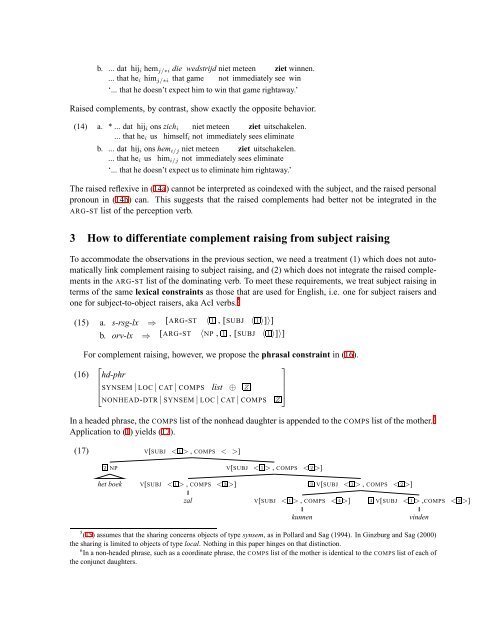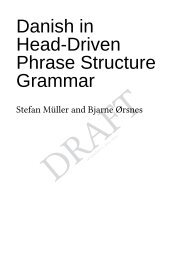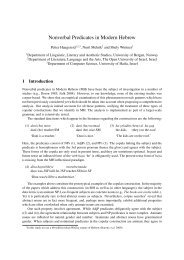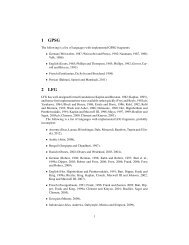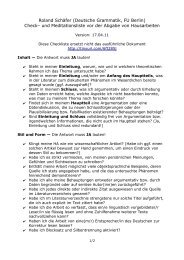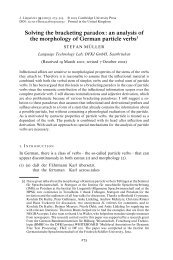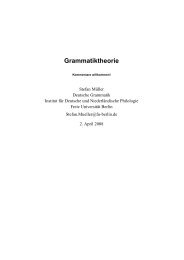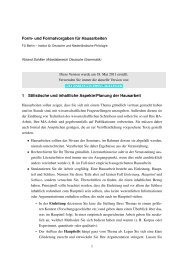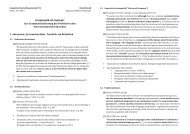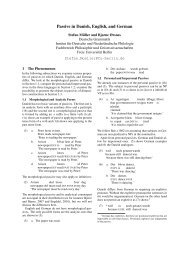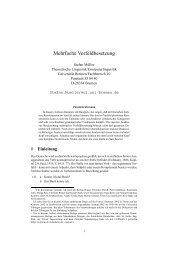Why and how to differentiate complement raising from subject ...
Why and how to differentiate complement raising from subject ...
Why and how to differentiate complement raising from subject ...
You also want an ePaper? Increase the reach of your titles
YUMPU automatically turns print PDFs into web optimized ePapers that Google loves.
. ... dat hiji hemj/∗i die wedstrijd niet meteen ziet winnen.<br />
... that hei himj/∗i that game not immediately see win<br />
‘... that he doesn’t expect him <strong>to</strong> win that game rightaway.’<br />
Raised <strong>complement</strong>s, by contrast, s<strong>how</strong> exactly the opposite behavior.<br />
(14) a. * ... dat<br />
... that<br />
hiji ons zichi niet meteen ziet uitschakelen.<br />
hei us himselfi not immediately sees eliminate<br />
hiji ons hemi/j niet meteen ziet uitschakelen.<br />
hei us himi/j not immediately sees eliminate<br />
‘... that he doesn’t expect us <strong>to</strong> eliminate him rightaway.’<br />
b. ... dat<br />
... that<br />
The raised reflexive in (14a) cannot be interpreted as coindexed with the <strong>subject</strong>, <strong>and</strong> the raised personal<br />
pronoun in (14b) can. This suggests that the raised <strong>complement</strong>s had better not be integrated in the<br />
ARG-ST list of the perception verb.<br />
3 How <strong>to</strong> <strong>differentiate</strong> <strong>complement</strong> <strong>raising</strong> <strong>from</strong> <strong>subject</strong> <strong>raising</strong><br />
To accommodate the observations in the previous section, we need a treatment (1) which does not au<strong>to</strong>matically<br />
link <strong>complement</strong> <strong>raising</strong> <strong>to</strong> <strong>subject</strong> <strong>raising</strong>, <strong>and</strong> (2) which does not integrate the raised <strong>complement</strong>s<br />
in the ARG-ST list of the dominating verb. To meet these requirements, we treat <strong>subject</strong> <strong>raising</strong> in<br />
terms of the same lexical constraints as those that are used for English, i.e. one for <strong>subject</strong> raisers <strong>and</strong><br />
one for <strong>subject</strong>-<strong>to</strong>-object raisers, aka AcI verbs. 5<br />
(15) a. s-rsg-lx ⇒<br />
b. orv-lx ⇒<br />
[ARG-ST 〈 1 , [SUBJ 〈 1 〉]〉]<br />
[ARG-ST 〈NP , 1 , [SUBJ 〈 1 〉]〉]<br />
For <strong>complement</strong> <strong>raising</strong>, <strong>how</strong>ever, we propose the phrasal constraint in (16).<br />
(16) ⎡<br />
hd-phr<br />
⎢<br />
⎣SYNSEM<br />
| LOC | CAT | COMPS list ⊕ Z<br />
⎤<br />
⎥<br />
⎦<br />
NONHEAD-DTR | SYNSEM | LOC | CAT | COMPS Z<br />
In a headed phrase, the COMPS list of the nonhead daughter is appended <strong>to</strong> the COMPS list of the mother. 6<br />
Application <strong>to</strong> (1) yields (17).<br />
(17) V[SUBJ < 1 > , COMPS < >]<br />
2 NP<br />
het boek<br />
V[SUBJ < 1 > , COMPS < 3 >]<br />
zal<br />
V[SUBJ < 1 > , COMPS < 2 >]<br />
V[SUBJ < 1 > , COMPS < 4 >]<br />
kunnen<br />
3 V[SUBJ < 1 > , COMPS < 2 >]<br />
4 V[SUBJ < 1 > ,COMPS < 2 >]<br />
vinden<br />
5 (15) assumes that the sharing concerns objects of type synsem, as in Pollard <strong>and</strong> Sag (1994). In Ginzburg <strong>and</strong> Sag (2000)<br />
the sharing is limited <strong>to</strong> objects of type local. Nothing in this paper hinges on that distinction.<br />
6 In a non-headed phrase, such as a coordinate phrase, the COMPS list of the mother is identical <strong>to</strong> the COMPS list of each of<br />
the conjunct daughters.


